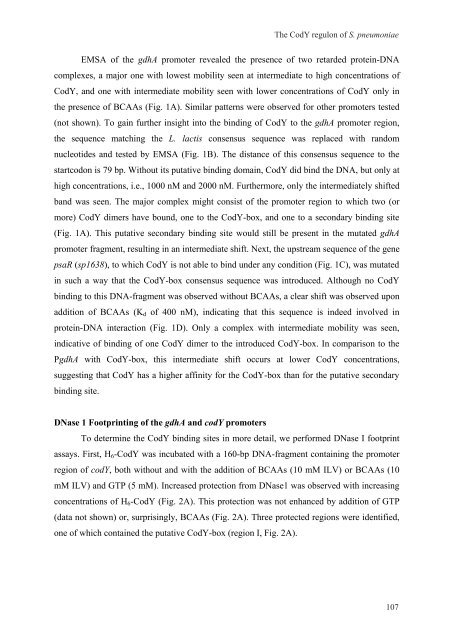Gene regulation in Streptococcus pneumoniae - RePub - Erasmus ...
Gene regulation in Streptococcus pneumoniae - RePub - Erasmus ...
Gene regulation in Streptococcus pneumoniae - RePub - Erasmus ...
You also want an ePaper? Increase the reach of your titles
YUMPU automatically turns print PDFs into web optimized ePapers that Google loves.
The CodY regulon of S. <strong>pneumoniae</strong><br />
EMSA of the gdhA promoter revealed the presence of two retarded prote<strong>in</strong>-DNA<br />
complexes, a major one with lowest mobility seen at <strong>in</strong>termediate to high concentrations of<br />
CodY, and one with <strong>in</strong>termediate mobility seen with lower concentrations of CodY only <strong>in</strong><br />
the presence of BCAAs (Fig. 1A). Similar patterns were observed for other promoters tested<br />
(not shown). To ga<strong>in</strong> further <strong>in</strong>sight <strong>in</strong>to the b<strong>in</strong>d<strong>in</strong>g of CodY to the gdhA promoter region,<br />
the sequence match<strong>in</strong>g the L. lactis consensus sequence was replaced with random<br />
nucleotides and tested by EMSA (Fig. 1B). The distance of this consensus sequence to the<br />
startcodon is 79 bp. Without its putative b<strong>in</strong>d<strong>in</strong>g doma<strong>in</strong>, CodY did b<strong>in</strong>d the DNA, but only at<br />
high concentrations, i.e., 1000 nM and 2000 nM. Furthermore, only the <strong>in</strong>termediately shifted<br />
band was seen. The major complex might consist of the promoter region to which two (or<br />
more) CodY dimers have bound, one to the CodY-box, and one to a secondary b<strong>in</strong>d<strong>in</strong>g site<br />
(Fig. 1A). This putative secondary b<strong>in</strong>d<strong>in</strong>g site would still be present <strong>in</strong> the mutated gdhA<br />
promoter fragment, result<strong>in</strong>g <strong>in</strong> an <strong>in</strong>termediate shift. Next, the upstream sequence of the gene<br />
psaR (sp1638), to which CodY is not able to b<strong>in</strong>d under any condition (Fig. 1C), was mutated<br />
<strong>in</strong> such a way that the CodY-box consensus sequence was <strong>in</strong>troduced. Although no CodY<br />
b<strong>in</strong>d<strong>in</strong>g to this DNA-fragment was observed without BCAAs, a clear shift was observed upon<br />
addition of BCAAs (Kd of 400 nM), <strong>in</strong>dicat<strong>in</strong>g that this sequence is <strong>in</strong>deed <strong>in</strong>volved <strong>in</strong><br />
prote<strong>in</strong>-DNA <strong>in</strong>teraction (Fig. 1D). Only a complex with <strong>in</strong>termediate mobility was seen,<br />
<strong>in</strong>dicative of b<strong>in</strong>d<strong>in</strong>g of one CodY dimer to the <strong>in</strong>troduced CodY-box. In comparison to the<br />
PgdhA with CodY-box, this <strong>in</strong>termediate shift occurs at lower CodY concentrations,<br />
suggest<strong>in</strong>g that CodY has a higher aff<strong>in</strong>ity for the CodY-box than for the putative secondary<br />
b<strong>in</strong>d<strong>in</strong>g site.<br />
DNase 1 Footpr<strong>in</strong>t<strong>in</strong>g of the gdhA and codY promoters<br />
To determ<strong>in</strong>e the CodY b<strong>in</strong>d<strong>in</strong>g sites <strong>in</strong> more detail, we performed DNase I footpr<strong>in</strong>t<br />
assays. First, H6-CodY was <strong>in</strong>cubated with a 160-bp DNA-fragment conta<strong>in</strong><strong>in</strong>g the promoter<br />
region of codY, both without and with the addition of BCAAs (10 mM ILV) or BCAAs (10<br />
mM ILV) and GTP (5 mM). Increased protection from DNase1 was observed with <strong>in</strong>creas<strong>in</strong>g<br />
concentrations of H6-CodY (Fig. 2A). This protection was not enhanced by addition of GTP<br />
(data not shown) or, surpris<strong>in</strong>gly, BCAAs (Fig. 2A). Three protected regions were identified,<br />
one of which conta<strong>in</strong>ed the putative CodY-box (region I, Fig. 2A).<br />
107<br />
107

















